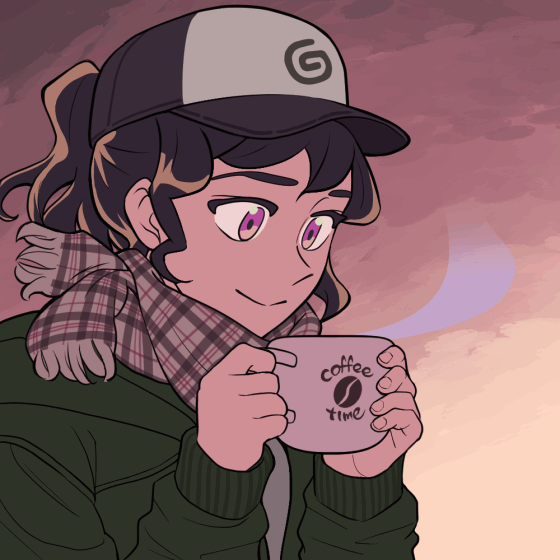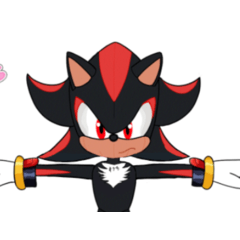Practicing Short Animations, also known as Moving Illustrations or Ugoira
Compatible with Clip Studio Paint Ver. 2.2.0
Give your illustrations some eye-catching movement for social media!
Moving even just a part of your illustration, such as the mouth, hair, hands, or background, can make it seem more lifelike.
In this tutorial, we'll show you how to make your characters blink with a basic technique that can be easily done by first-time animators.
For more details on animating motion, refer to the following TIPS article.
I’m going to make a simple illustration by only moving a section of it.
Here I'll explain how to make eyes blink and the eyebrows move.

The Blink
1. Dividing the parts
I cut out the parts of the illustration that I want to move and put them in the animation folder separately from the parts I want to remain still.
Additionally, before you start working on anything, be sure to keep a duplicate of your original illustration.
You can duplicate a file by selecting [File] > [Save Duplicate] > [.clip].
(1) Merge the character's layers
Merge your character's illustration into a single layer and only store the moving parts in the animation folder.
Note:
In this example, the layers are merged into a single layer, but you can merge multiple layers such as line art and color fills into a layer folder in the animation folder to create a single animation cel.
For a detailed explanation, please see the following tutorial.
(2) Click [Select] tool > [Selection Pen] sub tool and create a selection of the eyes and eyebrows.
If the selection area isn't perfect, it's okay as long as it remains within the painted area of the skin.
Note:
If the eyes and eyebrows didn't overlap with any other line art, I could have used the [Polyline] sub tool, but the edges of the eyes overlap, so I used the [Selection pen] sub tool to create a more refined selection.
(3) Once selected, copy and paste the area. A layer for the eyes and eyebrows will be created in the [Layer] palette.
(4) From the [Animation] menu, select [New animation layer] > [Animation folder] and create an animation folder (named “b”). We will move the eye and eyebrow layer here.
Change the name of the eyes and eyebrows layer to "1".
Note:
Animation folders created in the [Layer] palette from [Animation] > [New animation layer] > [Animation folder] will appear in the [Timeline] palette as well.
Note: Cels (frames) cannot be edited unless they are placed on the timeline. Check the timeline when you cannot edit a cel.
If you do not see anything on the Timeline palette, you will need to create a [New Timeline]. Please see below for more information.
(5) Using the [Pen] tool, color in the eyes, and eyebrows with the skin color from the original illustration.
The moving parts, eyes and eyebrows, and the rest of the parts that don't move are now divided into two folders. I named the layer that doesn't move," a," and the animation folder for the eyes and eyebrows that I want to move, "b."
2. Drawing closed eyes
Add two layers to add a blinking animation. Move the following three layers (cels).
・Open eyes cel (current eyes and eyebrows)
・Inbetween cel
・Closed eyes cel
Here, we will create a closed eyes cel.
(1) Select the third frame in the Timeline palette. Click New Raster Layer on the Layer palette. The cel will then be specified on the Timeline palette.
Note:
If you cannot specify a cel from the Layer palette, turn on Add cel to frame when adding layer in Animation in the Preferences dialog.
(2) Select Animation > Show animation cels > Enable onion skin, to show the onion skin. Refer back to Layer (1) with the open eyes to make Layer (2) with the closed eyes. The key is to imagine the movement of the eyelids lowering and to pay attention to the width and round shape of the closed eyes.
Draw near the bottom of the open eye. If it’s too high, the closing motion will look strange.
(3) The eyebrows should be almost the same as the eyebrows in layer 1, except that they are slightly lower.
3. Inbetweening
(1) Select the frame between "1" and "2" on the Timeline palette, and click New Raster Layer from the Layer palette. This “1a” cel will then be specified on the Timeline palette.
(2) Select Animation menu > Edit track > Rename in timeline order. The cel and layer names will be changed to "1", "2", and "3" according to the timeline display order.
(3) Draw the inbetween of the open and closed eye on Layer 2. Do this while referencing Layers 1 and 3 by displaying their onion skins.
(4) Connect the edges of the eyelid of 1 and 3 with motion arcs. Here, we placed the inbetween on the upper half of the arc to accentuate the motion. This slow-in/slow-out makes the motion more realistic.
Note:
Motion arc
A motion arc is a line that indicates the trajectory of a motion. An arc contains dots that specify frames.
Slow-in/Slow-out
In animation, the gradual acceleration of a moving object is called a slow-out. In contrast, the gradual deceleration of an object is called a slow-in. The frames of a slow-moving object should be near each other, with the opposite being true with a fast object.
(5) Carefully draw the inbetween eyelashes while referencing the onion skins and arc. Be careful of overlapping sections.
(6) The inbetweened irises should be pulled downward by the eyelids.
4. Checking motion
(1) Right-click any frame on the [Timeline] palette, and specify cels on the timeline from the pop-up menu. The frames of the motionless folder “a” should all be 1.
(2) Here, the timeline of Folder “b,” or the eyes and eyebrows, was set to 1 > 3 > 2 > 1 > 1.
The first two frames were set to 1 (open) > 3 (closed) without an inbetween to simulate a blink.
When opening, the frames were set to 3 (closed) > 2 (inbetween) > 1 (open). This makes the opening motion slower than the closing motion.
(3) Finish by clicking the [Timeline] palette’s [Play/Stop] and checking the motion.
In the same way, you can add motion to the steam in another animation folder and paint each cel to complete.

Completed works can be exported as animated GIFs and posted to social media (Twitter, etc.).
From the [File] menu, click [Export animation], then [Animated GIF] to export the animation as an animated GIF.
The Bouncing Ball
Let’s go over “The bouncing ball” as well, another exercise that’s often introduced alongside the blink as an entry-level animation.
When animating, drawing cels in chronological order is called “Straight ahead action.” This method can be used for simple animation that does not need keyframes. Animating simple shapes with straight-ahead action is useful when practicing the movement of objects.
(1) Draw a ball on the bottom layer. Each ball will be drawn on the following cel.
(2) Draw the second cel. Displaying the previous cel with [Animation] menu > [Show animation cels] > [Enable onion skin] can make this easier.
We are assuming the ball will bounce, as shown below.
(3) Continue drawing the following third, fourth, etc. frames.
(4) The finished animation is a ball that bounces, as shown below.
The deceleration at the top of the arc and the acceleration as it falls and bounces is shown using slow-ins/slow-outs. The squash at the bottom is important as well.
Quick animations like this can be made swiftly and will help you get used to the software. Please try it out.
























Comment